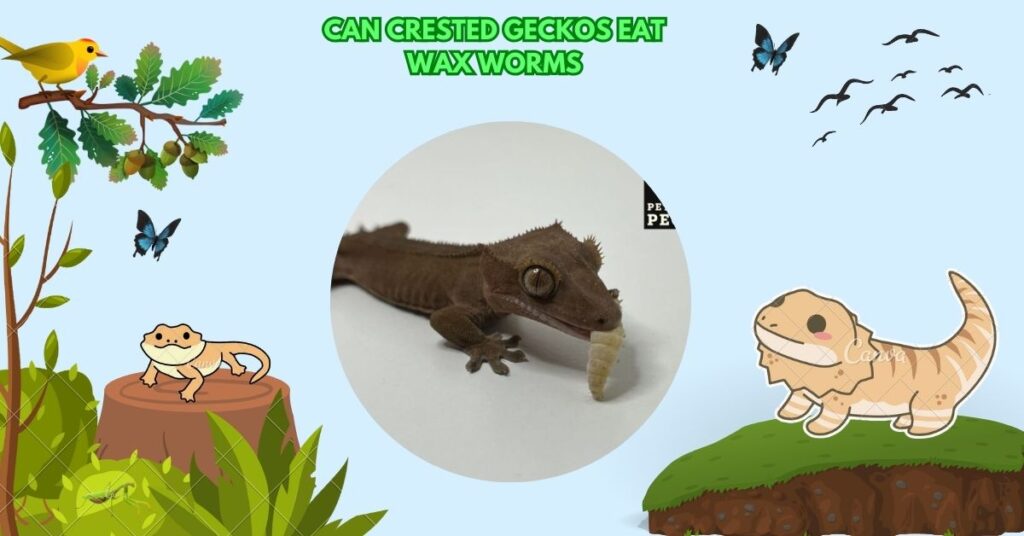Crested geckos are omnivorous reptiles native to New Caledonia, known for their diverse diet that includes fruits, nectar, and a variety of insects. In captivity, providing a balanced diet is crucial for their health and well-being.
Yes, crested geckos can eat waxworms as an occasional treat, no more than once or twice a month. They add fat to the diet but should be fed in moderation. Waxworms are safe, but they shouldn’t be a primary food source.
This comprehensive guide explores the suitability of waxworms as a food source for crested geckos, including their nutritional value, feeding frequency, benefits, and potential risks.
Understanding Waxworms
Waxworms are the larval stage of wax moths, primarily the greater wax moth (Galleria mellonella) and the lesser wax moth (Achroia grisella). In the wild, these larvae inhabit beehives, feeding on beeswax, honey, and other hive materials, which has led to their reputation as pests among beekeepers. In captivity, waxworms are commonly bred as feeder insects for reptiles, birds, and fish due to their soft bodies and high-fat content.
Nutritional Profile of Waxworms
When considering waxworms as a food source for crested geckos, it’s essential to examine their nutritional composition:
- Protein: Approximately 14.1%
- Fat: Approximately 24.9%
- Fiber: Approximately 3.4%
- Moisture: Approximately 58.5%
- Calcium: 243 mg/kg
- Phosphorus: 1950 mg/kg
The calcium-to-phosphorus ratio in waxworms is notably imbalanced, with a Ca:P ratio of approximately 1:8, which is less than ideal for reptiles.
Benefits of Feeding Waxworms to Crested Geckos
- Palatability: Many crested geckos find waxworms highly palatable, making them useful for enticing picky eaters or providing a special treat.
- Soft Exoskeleton: The soft bodies of waxworms make them easy to digest, reducing the risk of impaction compared to harder-shelled insects.
- Energy Boost: The high-fat content can provide a quick energy boost, beneficial for underweight geckos or those needing to gain weight.
Risks and Considerations
- High-Fat Content: The elevated fat levels can lead to obesity and related health issues if fed too frequently.
- Nutritional Imbalance: The poor calcium-to-phosphorus ratio necessitates careful supplementation to prevent metabolic bone disease.
- Potential for Addiction: Some crested geckos may develop a preference for waxworms, leading to refusal of other, more nutritious foods.
Feeding Guidelines
To incorporate waxworms into your crested gecko’s diet safely, consider the following guidelines:
- Frequency: Offer waxworms as an occasional treat, no more than once or twice a month, to prevent excessive fat intake.
- Quantity: Limit the number of waxworms per feeding session to 2-3 for adult geckos. Adjust the quantity appropriately for juveniles, ensuring the size of the waxworm is not larger than the space between the gecko’s eyes.
- Supplementation: Always dust waxworms with a high-quality calcium supplement to address the calcium-phosphorus imbalance.
- Gut-Loading: Although waxworms are less commonly gut-loaded due to their feeding habits, providing them with nutrient-rich foods like honey and bran before feeding can enhance their nutritional value.
Alternatives to Waxworms
While waxworms can be an occasional treat, it’s important to provide a variety of other feeder insects that offer better nutritional profiles:
- Crickets: High in protein and widely available, crickets are a staple feeder insect for crested geckos.
- Dubia Roaches: These insects have a favorable protein-to-fat ratio and are easy to digest.
- Silkworms: Low in fat and high in protein, silkworms are an excellent choice for regular feeding.
- Hornworms: Also known as goliath worms, they are nutritious and hydrating but should be fed in moderation due to their size.
Monitoring Your Crested Gecko’s Health
Regularly assess your crested gecko’s body condition and behavior to ensure they maintain a healthy weight and exhibit normal activity levels. If you notice signs of obesity, lethargy, or dietary imbalance, reevaluate their diet and consult a veterinarian specializing in reptiles.
FAQs
Are wax worms ok for crested geckos?
Yes, waxworms can be fed to crested geckos occasionally as a treat, but they should only be given once or twice a month.
What worms are safe for crested geckos?
Crested geckos can safely eat silkworms, hornworms, and crickets. Waxworms should be fed in moderation.
Can I feed my geckos wax worms?
Yes, you can feed your crested gecko waxworms, but they should only be offered as a rare treat, no more than once or twice a month.
What not to feed crested geckos?
Avoid feeding crested geckos mealworms, wild-caught insects, or anything toxic like citrus fruits.
What is toxic to crested geckos?
Citrus fruits, avocado, and some wild plants are toxic to crested geckos and should be avoided.
How long do waxworms live?
Waxworms typically live 1 to 2 months, so they should be used shortly after purchase.
Can you feed wax worms?
Yes, waxworms can be fed to crested geckos, but only occasionally and in moderation due to their high-fat content.
What kind of bugs can I feed my crested gecko?
Crested geckos can eat crickets, silkworms, hornworms, and other nutrient-rich feeder insects.
Can wax worms lay eggs?
Yes, female waxworms can lay eggs, but they do so in their natural habitat, like beehives.
Do crested geckos like to be held?
Crested geckos tolerate handling but may not enjoy it. Always handle them gently.
Conclusion
In summary, crested geckos can eat waxworms, but only as an occasional treat due to their high-fat content and poor calcium-to-phosphorus ratio. By adhering to proper feeding guidelines and offering a diverse diet rich in appropriately supplemented feeder insects, you can promote the health and longevity of your crested gecko.

